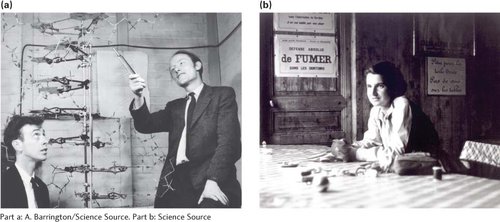Watson and Crick’s Discovery of the Three-Dimensional Structure of DNA
The experiments on the nature of the genetic material set the stage for one of the most important advances in the history of biology: the discovery of the three-dimensional structure of DNA by James Watson and Francis Crick in 1953. Before Watson and Crick’s breakthrough, much of the basic chemistry of DNA had already been determined by Miescher, Kossel, Levene, Chargaff, and others, who had established that DNA consists of nucleotides and that each nucleotide contains a sugar, a base, and a phosphate group. However, how the nucleotides fit together in the three-dimensional structure of the molecule was not at all clear.

8.5 X-ray diffraction provides information about the structures of molecules.
[Photograph: Science Source.]
In 1947, William Astbury began studying the three-dimensional structure of DNA by using a technique called X-ray diffraction (Figure 8.5), in which X-rays beamed at a molecule are reflected in specific patterns that reveal aspects of the structure of the molecule. However, his diffraction images did not provide enough resolution to reveal the structure. A research group at King’s College in London, led by Maurice Wilkins, also used X-ray diffraction to study DNA. Working in Wilkins’s laboratory, Rosalind Franklin obtained strikingly better images of the molecule. However, Wilkins and Franklin’s progress in solving the structure was impeded by the personal discord between them.

8.6 James Watson and Francis Crick (a) developed a three-dimensional model of the structure of DNA based in part on X-ray diffraction photographs taken by Rosalind Franklin (b).
[Part a: A. Barrington/Science Source. Part b: Science Source.]
Watson and Crick investigated the structure of DNA not by collecting new data, but by using all available information about the chemistry of DNA to construct molecular models (Figure 8.6a). They used the excellent X-ray diffraction photographs taken by Rosalind Franklin (Figure 8.6b), and by applying the laws of structural chemistry, they were able to limit the number of possible structures that DNA could assume. They tested various structures by building models made of wire and metal plates. With their models, they were able to see whether a structure was compatible with chemical principles and with the X-ray images.
Page 214
The key to solving the structure came when Watson recognized that an adenine base could bond with a thymine base and that a guanine base could bond with a cytosine base; these pairings accounted for the base ratios that Chargaff had discovered earlier. The model developed by Watson and Crick showed that DNA consists of two strands of nucleotides that run in opposite directions (are antiparallel) and wind around each other to form a right-handed helix, with the sugars and phosphates on the outside and the bases in the interior. They recognized that the double-stranded structure of DNA with its specific base pairing provided an elegant means by which the DNA could be replicated. Watson and Crick published an electrifying description of their model in Nature in 1953. At the same time, Wilkins and Franklin each published their X-ray diffraction data, which demonstrated that DNA was helical in structure.
Many have called the solving of DNA’s structure the most important biological discovery of the twentieth century. For their discovery, Watson and Crick, along with Maurice Wilkins, were awarded the Nobel Prize in Chemistry in 1962. Rosalind Franklin had died of cancer in 1958 and thus could not be considered a candidate for the shared prize, but many scholars and historians believe that she should receive equal credit for solving the structure of DNA.
Following the discovery of DNA’s structure, much research focused on how genetic information is encoded within the base sequence and how this information is copied and expressed. Even today, the details of DNA structure and function continue to be the subject of active research.
CONCEPTS
By collecting existing information about the chemistry of DNA and building molecular models, Watson and Crick were able to discover the three-dimensional structure of the DNA molecule.

